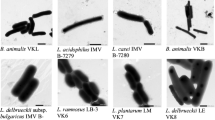Abstract
Eight Bifidobacterium longum strains, including reported probiotic strains (commercial and noncommercial), collection strains, and laboratory isolates, were investigated for their ability to adhere to mucin as well as their ability to tolerate acid and bile. Strains could be discriminated based on their sensitivity at pH values of 2.0 to 2.5 and bile concentrations of 0.5% to 2.0%. B. longum NCC 2705, a strain known for its probiotic properties, showed the highest resistance to gastrointestinal conditions, whereas the commercial probiotic strains B. longum BB 536 and SP 07/3 were the least resistant. In parallel, the human isolate B. longum BIF 53 showed the highest adhesion to mucin, whereas the commercial probiotic strains B. longum W 11, BB 536, and SP 07/3 were the least adhesive. The bacterial adhesion to mucin of strains B. longum NCC 2705 and BIF 53 could be reduced by lysozyme, indicating that cell-wall components are involved in the adhesion process. These results showed that there is no obvious link between adhesion and resistance to gastrointestinal conditions and the probiotic status of the studied strains. This calls for a definition of conditions for in vitro tests that better predict the in vivo functionality of probiotic strains.

Similar content being viewed by others
References
Bianchi MA, del Rio D, Pellegrini N, Sansebastiano G, Neviani E, Brighenti F (2004) A fluorescence-based method for the detection of adhesive properties of lactic acid bacteria to Caco-2 cells. Lett Appl Microbiol 39:301–305
Collado MC, Gueimonde M, Hernandez M, Sanz Y, Salminen S (2005) Adhesion of selected Bifidobacterium strains to human intestinal mucus and the role of adhesion in enteropathogen exclusion. J Food Prot 68:2672–2678
Collado MC, Hernandez M, Sanz Y (2005) Production of bacteriocin-like inhibitory compounds by human fecal Bifidobacterium strains. J Food Prot 68:1034–1040
Collado MC, Moreno Y, Cobo JM, Hernandez M (2006) Microbiological evaluation and molecular characterization of bifidobacteria strains in commercial fermented milks. Eur Food Res Technol 222:112–117
FAO/WHO working group (2002) Guidelines for the Evaluation of Probiotics in Food. Available at: ftp://ftp.fao.org/es/esn/food/wgreport2.pdf. Joint FAO/WHO Working Group, London, Ontario, Canada, April 30 and May 1
Gueimonde M, Delgado S, Mayo B, Ruas-Madiedo P, Margolles A, De Los Reyes-Gavilan C (2004) Viability and diversity of probiotic Lactobacillus and Bifidobacterium populations included in commercial fermented milks. Food Res Int 37:839–850
Kirjavainen PV, Ouwehand AC, Isolauri E, Salminen SJ (1998) The ability of probiotic bacteria to bind to human intestinal mucus. FEMS Microbiol Lett 167:185–189
Lahtinen SJ, Gueimonde M, Ouwehand AC, Reinikainen JP, Salminen SJ (2006) Comparison of four methods to enumerate probiotic bifidobacteria in a fermented food product. Food Microbiol 23:571–577
Mukai T, Kaneko S, Matsumoto M, Ohori H (2004) Binding of Bifidobacterium bifidum and Lactobacillus reuteri to the carbohydrate moieties of intestinal glycolipids recognized by peanut agglutinin. Int J Food Microbiol 90:357–362
Ouwehand AC, Salminen SJ (1998) The health effects of cultured milk products with viable and non-viable bacteria. Int Dairy J 8:749–758
Pineiro M, Stanton C (2007) Probiotic bacteria: legislative framework-requirements to evidence basis. J Nutr 137:850–853
Ruas-Madiedo P, Gueimonde M, Margolles A, De Los Reyes-Gavilan C, Salminen S (2006) Exopolysaccharides produced by probiotic strains modify the adhesion of probiotics and enteropathogens to human intestinal mucus. J Food Prot 69:2011–2015
Senok AC, Ismaeel AY, Botta GA (2005) Probiotics: Facts and myths. Clin Microbiol Infect 11:958–966
Servin AL, Coconnier MH (2003) Adhesion of probiotic strains to the intestinal mucosa and interaction with pathogens. Best Pract Res Cl Ga 17:741–754
Société des Produits Nestlé S.A., Arigoni F, Delley M, Mollet B, Pridmore RD, Schell MA et al (2002) Genome sequence and protection from pathogenic microorganisms by strain NCC2705 of Bifidobacterium longum. European Patent 1227152
Acknowledgments
Nestec (Nestec Ltd, Nestlé Research Center Lausanne, Switzerland) and Comercial Química Masó (Barcelona, Spain) are acknowledged for providing the strains B. longum NCC 2705 and B. longum BB 536, respectively. This work was supported by the “Ministère de l'Enseignement Supérieur et de la Recherche” and by Grants No. AGL2005-05788-C02-01 and Consolider Fun-C-Food CSD2007-00063 from the Spanish Ministry of Science and Education (MEC). The postdoctoral grant to M Medina from MEC (Spain) is also fully acknowledged.
Author information
Authors and Affiliations
Corresponding author
Rights and permissions
About this article
Cite this article
Izquierdo, E., Medina, M., Ennahar, S. et al. Resistance to Simulated Gastrointestinal Conditions and Adhesion to Mucus as Probiotic Criteria for Bifidobacterium longum Strains. Curr Microbiol 56, 613–618 (2008). https://doi.org/10.1007/s00284-008-9135-7
Received:
Accepted:
Published:
Issue Date:
DOI: https://doi.org/10.1007/s00284-008-9135-7




